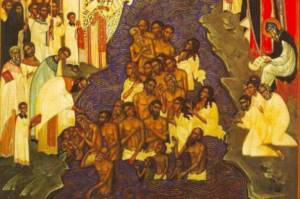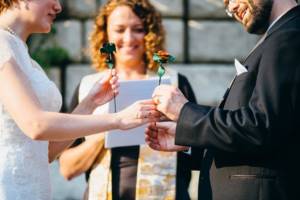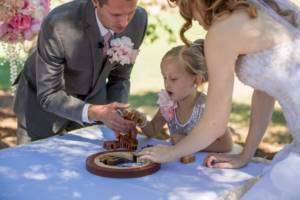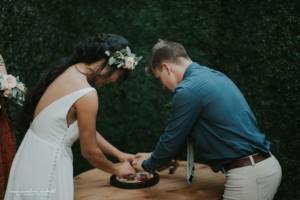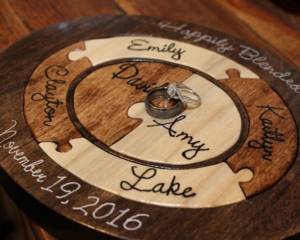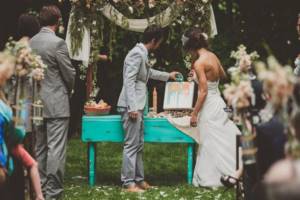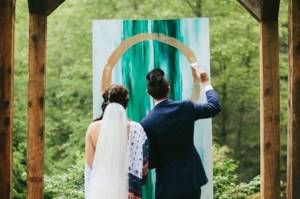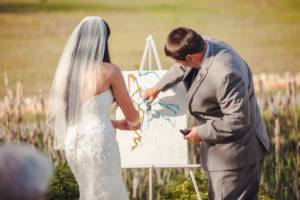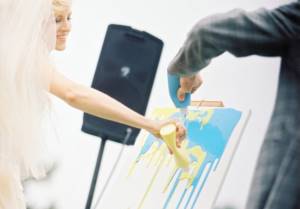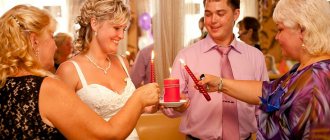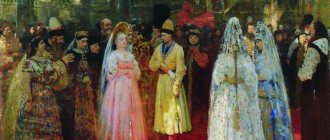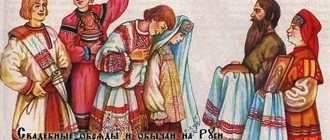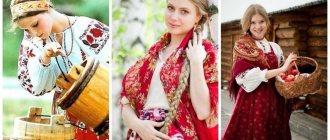Russian wedding ceremony: traditions and creativity
Increasingly, young people on the eve of their wedding are interested in folk wedding traditions. Sometimes even some elements of a folk wedding are used in the wedding celebration. Having two daughters, I sometimes wonder how I will marry them off. What are the traditions and beliefs?
I was very interested in how our ancestors celebrated their weddings?
nothing is known about the wedding rites of our ancient ancestors, and we mean really ancient ones - those who lived according to the laws of the Vedic worldview for several millennia . What is presented to us now as the most ancient antiquity, in fact, is not so. The most famous source on the issue of wedding customs of the ancient Slavs is the chronicle of the Christian priest Nestor, “The Tale of Bygone Years” of the 12th century. He writes that the customs of the ancient Slavs varied from tribe to tribe, and in some tribes the so-called “kidnapping” was practiced - the groom kidnapped the bride at the games, having previously agreed with her about the abduction - and polygamy: “I go to the games... and then kidnap the wife for himself , who met with her: the name has two and three wives...” Historian N.M. Karamzin continues the Nestorovian tradition of describing, in his opinion, half-wild Slavs in his “History of the Russian State”, Vol. 1, Chapter 3, where he tells horror stories about the family life of hospitable, chaste and faithful in marriage, but not covered by the “beneficent teaching of the Christian Faith” ”, our near ancestors: “They considered wives to be perfect slaves, at least unrequited; they were not allowed to contradict themselves or complain; they burdened them with labor and economic worries and imagined that the wife, dying with her husband, should serve him in the next world. This slavery of wives occurred, it seems, because their husbands usually bought them...” After the death of her husband, the Slav woman usually burned herself at the stake along with his corpse. The living widow dishonored the entire family. The wedding ceremony, which is described as “ancient Russian” , was formed relatively recently - after Christianity was imposed on Russia and they tried to knock out as many Vedic traditions as possible from popular life, to which many rulers of Russia consistently had a hand, for example, the false Peter I, diligently instilled “progressive” European customs. However, some “pagan” elements are preserved even in modern wedding rituals, for example, showering with grain, poppy or hops, carrying the bride over the threshold, tying the hands of the bride and groom with a towel, and others.
Such rituals have come down to us. It was believed that in order to preserve the unity of the family, it was necessary to place an unlocked lock under the threshold of the house at the time when the bride and groom were taken out of the church. When they stepped over the threshold, the lock was immediately lifted and closed, and the key was thrown into a river or well so that the husband and wife would live in joy and harmony and never be separated.
To protect the bride from damage and the evil eye, earless needles and headless pins were pierced into the hem of her dress, into her shirt, into her collar, and she wrapped her body in scraps of hemstitches. All this was done so that the newlyweds would not be “spoiled” on their wedding day. It was believed that no healer could spoil a person if he had earless and headless needles and pins. For the same purpose, nails or large needles were driven crosswise into the doorframe of the front door, and a woolen thread was tied around the bride’s waist; In addition, the stitches on the nightgown, made by hand by the bride herself, were considered reliable protection against betrayal and deception. After Christianization, it was customary for young people in Rus' to marry at an early age, starting from 12 years old. In this case, the decision about marriage was made by the parents, and the children were informed about this decision shortly before the wedding.
However, in some regions other behavior was allowed. The guy who spotted the bride had to tell his father about it. If he received approval, then two matchmakers with bread were sent to the girl’s house.
In the Middle Ages, weddings in Rus' were carried out according to the following plan: matchmaking, bridesmaids, hand-raising, howling, bachelorette party, ransom, wedding, festivities, wedding feast. Each stage of the wedding ceremony included many ritual actions of the bride, groom, groomsman, groomsman, future mother-in-law and other participants, as well as ritual songs, laments and various formal procedures. The rituals symbolized the transition of a girl from her father’s clan to her husband’s clan. The bride, as it were, “died” for her own clan (hence the howling and lamentation) and was “born” into another clan.
Matchmaking
Matchmaking was preceded by the collection of information about the bride - “they found out the breed . The first day of matchmaking was scheduled if the information received satisfied the groom's family. The matchmaker was usually the groom's relatives - father, brother, etc., less often - the mother, although the matchmaker could not be a relative. Matchmaking was preceded by a certain agreement between the parents of the bride and groom. Often the matchmaker did not speak directly about the purpose of his visit, but pronounced some ritual text. The bride's parents answered him in the same manner. The text could be like this: You have a flower, and we have a garden. Is it possible for us to transplant this flower into our little garden? A young gander is looking for a goose. Is there a little goose lurking in your house? We have a little goose, but she’s still young...
The bride's parents had to refuse the first time, even if they were happy about the wedding. The matchmaker had to persuade them. After the matchmaking, the parents gave the matchmaker an answer. The girl’s consent was not required (if asked, it was a formality); sometimes even matchmaking could take place in the absence of the girl. Most often, specially hired matchmakers, sometimes relatives of the groom, acted as matchmakers; this could be a father, godfather, godmother, or uncle. Their responsibilities included not only the matchmaking itself, but also often the choice of the bride herself from suitable candidates. They had to find out what kind of dowry was given for the bride and what it consisted of. In addition, through the matchmaker, the groom learned details about the appearance and character of the bride, whom in some cases he could see openly only on the wedding day.
Bride
Every bride had to go through the bride, no matter how favorable the information collected about her was. Bridesmaids were held after the matchmaking, before the handshake.
The girl was taken to the middle of the room and asked to perform various actions: walk in front of the bench where the matchmakers were sitting, raise both hands in turn, remove the scarf from her head, etc. With such a close examination, all physical flaws were visible.
At the end of the viewing, they waited for the groom's decision. If the bride was satisfied, we agreed on further actions. Or the caretakers would go out onto the porch for a meeting. Then the groom returned, and the girl’s mother brought him a glass of honey. If the guy drank the whole glass, wait for the matchmakers. If you brought it to your mouth and immediately put it on the table, there would be no wedding.
They also “looked” at the groom’s household. This was important especially if the matchmakers came from a foreign village. The groom was required to guarantee the prosperity of his future wife. Therefore, her parents inspected the farm very carefully. The main requirements for farming were an abundance of livestock and bread, clothing, and dishes. Often, after inspecting the farm, the bride's parents refused the groom. But, if the bride’s parents were satisfied with the results of the “grooming,” as the bridegroom was also called, then they set a day for public matchmaking—handshake.
Handshake
In different traditions, this ritual was called differently (“vaults”, “conspiracy”, “binge”, “singing” - from the word “sing”, “zaruchiny”, “zaporuki” - from the words “slap on the hands”, “betrothal”) ", "vaults" and many other names), but in any tradition it was from this day that the wedding itself began. After public announcement, only exceptional circumstances could disrupt the wedding (such as the bride's elopement). Usually the “conspiracy” takes place about two weeks after the matchmaking. The “conspiracy” took place in the bride’s house. Most of the village residents usually gathered for it, since the day of the “conspiracy” was determined after inspecting the groom’s household, and a few days before the “conspiracy” itself, this news spread throughout the village.
At the “conspiracy,” the guests were given refreshments, the parents of the bride and groom had to agree on the wedding day, who would be the groomsmen, upcoming expenses, the number of gifts, masonry (a form of financial support for the bride from the groom’s relatives), dowry, etc. d. Also, during the handshake, wedding ranks were distributed - roles distributed among the guests at the wedding. In conclusion, the fathers of the bride and groom beat each other's hands, often wearing canvas mittens to do this. All this was supposed to mean the strength and obligation of the contract. After the “handshake,” the bride was considered matched.
Vytie
The next period in some traditions was called a “week” (although it did not necessarily last exactly a week, sometimes up to two weeks). At this time, the dowry was being prepared. In northern traditions, the bride constantly wailed. In the south, every evening the groom and his friends came to the bride’s house (this was called “gatherings,” “parties,” and so on), and sang and danced. During the “week” the groom was supposed to arrive with gifts.
In the northern tradition, all actions during the “week” are accompanied by the bride’s laments, including the arrival of the groom.
Vytiye - wedding ceremony, ritual crying. Happens on half of the bride. Its purpose is to show that the girl lived well in her parents’ house, but now she has to leave. The bride said goodbye to her parents, girlfriends, will and spent all the time before the wedding “in tears and howls”, “in the dark”, which was associated with the hard work awaiting the young woman, saying goodbye to a young girl’s life. The bride was put on something like a veil, because of which she could not see anything, so the bride needed an escort. This ritual was called hanging.
hen-party
A bachelorette party is a meeting between the bride and her friends before the wedding. This was their last meeting before the wedding, so there was a ritual farewell to the bride and her friends. At the bachelorette party, the second key moment of the entire wedding ceremony took place (after the “hanging”) - the unbraiding of the girl’s braid. The bride's friends unbraided the braid. Unraveling the braid symbolizes the end of the girl’s former life. In many traditions, unraveling the braid was accompanied by a “farewell to red beauty.”
“Red Beauty” is a ribbon or ribbons woven into a girl’s braid. But first, her friends braided her braid for the last time, braiding it into a braid - a ribbon embroidered with pearls and beads. Then, wailing and crying, the friends unbraided the girl’s braid for the last time, and the bride passed the braid to her younger sister or unmarried friend. At the bachelorette party, the bride’s handmade creations, which she managed to make as a girl, were hung throughout the house. These were towels and napkins embroidered by the bride, shirts and dresses, homespun rugs. All the things she learned to do in her life.
An important element was also the ritual bathing of the bride in the bathhouse on the eve of the wedding. The healer read conspiracies against treason to the bride in the bathhouse.
She was hovered and doused with water several times. The last water after the bride was collected in a small container to be added to the groom's drink at the wedding. It was a conspiracy against betrayal and love.
First wedding day
On the first day of the wedding, the following usually happened: the arrival of the groom, departure to the crown, transportation of the dowry, arrival of the newlyweds at the groom's house, blessing, wedding feast.
Wedding ransom
In some traditions, on the morning of the wedding day, the groom must visit the bride's house and check if she is ready for the groom's arrival. When the groomsmen arrive, the bride should already be in her wedding clothes and sit in the red corner. The groom with his groomsmen, friends and relatives make up a wedding train with bells.
Bells and bells are not just decoration for the wedding train. They not only added festivity to the entire procession, but also protected it. “The bells are ringing - the evil force, the evil eye, the evil craft will not come.” As the train moved towards the bride's house, its participants (poezzhans) sang special “poezzhans” songs.
The arrival of the groom was accompanied by one or more ransoms. In most regional traditions, this is a purchase of the entrance to the house. Gates, doors, etc. can be redeemed. Both the groom himself and the groom can pay the ransom. The bride also took a bath. The bride can be bought either from her girlfriends or from her parents. Sometimes there was “deception” of the groom. The bride was brought out to him, covered with a scarf. For the first time, they might have brought out not the real bride, but another woman or even an old woman. In this case, the groom either had to go look for the bride, or buy her again.
Another ritual is used here - sweeping the road . This is done so that an object that could be damaged (hair, stone, etc.) is not thrown at the young people’s feet. The specific road that should be swept varies among different traditions. This could be the road in front of the bride’s house along which the groom’s train will travel, it could be the floor of the room along which the newlyweds will walk before leaving for the wedding, the road to the groom’s house after the wedding, and so on.
Arrival at the groom's house
After the wedding, the groom takes the bride to his home. Here they should be blessed by their parents. In many traditions, the bride and groom were seated on a fur coat with the fur turned outward. The skin of the animal served as a talisman. Bread in one form or another is required in the blessing ritual. In some regions, it was then fed to the cow so that it would produce more offspring.
wedding feast
After the wedding, the bride stops wailing.
From this moment the joyful and cheerful part of the ritual begins. Next, the newlyweds went to the bride’s house to buy gifts. Then the groom brings the bride to his house.
There should already be a rich meal ready for the guests. The wedding feast begins. During the feast they sang songs of praise. In addition to the bride and groom, they named their parents and groomsmen.
The feast could last two or three days. On the second day, the feast continued at the bride's house. If they feasted for three days, on the third they returned to the groom again.
“Putting down” and “waking up” the young
In the evening (or at night) the “laying of the newlyweds” took place - the matchmaker or the bed-maid prepared the wedding bed, which the groom had to buy. The feast often continued during this time.
The next morning (sometimes only a few hours later), a friend, matchmaker or mother-in-law “woke up” the newlyweds. Often after waking up, guests were shown the bride’s “honor” - a shirt or sheet with traces of blood. In other places, the groom testified to the bride’s “honor” by eating a scrambled egg, pancake or pie from the middle or the edge, or by answering ritual questions like “Did you break the ice or trample the dirt?” If the bride turned out to be “dishonest,” her parents could be ridiculed, a collar hung around her neck, the gate covered with tar, and so on.
Second wedding day. On the second day of the wedding, the bride usually performed some ritual actions. For example, the “young woman” fetching water with two oars on a yoke, scattering garbage, money, grain in the room - the young wife had to carefully sweep the floor, which was checked by the guests.
On the same day, the groom came to his mother-in-law. She treated him to specially prepared food (pancakes, scrambled eggs, etc.). The plate was covered with a scarf, and the son-in-law brought her a gift to redeem the scarf.
Third wedding day. The wedding was celebrated at the young husband's house on the third day. On this day, the matchmakers were “kicked out” of the house, the husband’s relatives smashed pots against the door, the matchmakers sang and danced on the benches. At the threshold of the young husband's house on the last day of the wedding celebration, a stake was driven in, symbolizing the end of feasts and festivities.
Russian folk wedding beliefs and signs
The wedding ritual has long been accompanied by certain rituals and signs associated with them. Rituals, having passed through the centuries, have become softer, simpler and more humane. But wedding signs, although they were replenished with new superstitions, remained just as strict. Whether to believe them or not is up to everyone to decide for themselves. But following “safety precautions” will help avoid unnecessary conflicts and quarrels at any wedding.
Any superstition did not arise out of nowhere. Human observation showed its strengths during the celebration of a wedding, noticing causes and their consequences. That is why most of the signs can be explained even by the most categorical people by ordinary life situations.
As a rule, all beliefs and signs for a wedding, what is possible and what is not, are, in one way or another, related to people’s health, preservation of property and the ability to be happy. For example, torn dresses and suits always mean grumpy relatives. Which is not surprising, because in ancient times, wedding attire was often a family property and was passed down by inheritance. And damage to such a dress easily led to a family scandal.
As for future happiness, everything here is traditionally built on the “vice versa” principle. So, if dishes break during a celebration, it means there will be no quarrels in family life. In modern interpretation, this sign has become a separate obligatory ritual, when the bride and groom, leaving the registry office, break the glasses in which they drink champagne “for good luck.” At the same time, over the centuries, people have combined this sign with another one: it is believed that if broken glasses fall into large pieces, then the first child will be a boy, and if they are small pieces, a girl.
Also, signs of a happy wedding advise the bride to cry before the celebration itself. In fact, in ancient times, brides cried without any special purpose, because they really left one family for another and forever left behind their free life. Today this is not at all the case, but from a psychological point of view, such tears help reduce nervous tension, which means that the celebration itself, as well as family life, will be a joy for the girl. Therefore, brides cried and cry at the wedding, sometimes not knowing that this is an important sign that promises happiness in marriage.
Wedding Dress
A girl moving into a new family was the key to prosperity and the future of an entire family. Hopes were pinned on her for the birth of children and grandchildren. And the ability to keep the house clean, create comfort and find a common language with new relatives is important for the personal happiness of every bride. Therefore, it is not surprising that it was the bride who was and remains under the closest attention of the guests. And most of the restrictions are associated with her actions and outfit.
Thus, signs about a wedding dress prohibit the bride:
- put on your outfit through your legs, not over your head;
- wear a borrowed wedding dress (although today this sign is not observed so strictly);
- wear a dress that has knots, laces and braids as decoration, but you can attach a special knot charm under the dress;
- dress and appear in a dress in front of the groom before the ceremony;
- wear a two-piece suit rather than a one-piece dress;
- let someone else try on something from your closet: a dress, veil, shoes or ring.
By observing these wedding signs and superstitions, the bride will avoid quarrels, poor health and early separation from the groom.
It is also believed that if the entire wedding dress was put on before the wedding, for example, during fitting, then the wedding itself will not take place. Therefore, when choosing in a store or studio, it is customary not to wear some part of the outfit. Most often - gloves.
As for the color of the dress, it hardly matters. White, cream, red... Popular wisdom condemns only green color, which has nothing to do with the wedding ritual. This is what you should avoid in your outfit.
Among the huge number of beliefs, you can also find warning signs:
a torn dress - to a grumpy and angry mother-in-law,
to sell a dress means to lose the protection of the clan.
And if you make a few stitches on the hem of the dress or sew two red ribbons, the bride will be protected from the evil eye. Also, the witness can pin a pin to the bride’s dress for the same purpose.
The best dress for a bride has long sleeves, a closed back, a floor-length skirt and embroidery as decoration. And by treating the wedding dress as a symbol of family wealth and a shrine, you can avoid a bad mood, both during the ceremony itself and after it.
What about shoes, underwear and various outfit details? There are rules here too. The bride is required to wear only white underwear. This is due to the fact that it is not just aesthetically pleasing and beautiful, but also symbolizes purity of thoughts. The belief itself does not depend in any way on the color of the dress.
Shoes should be comfortable and, best of all, old. This is a very practical superstition, because the wrong shoes can cause foot pain and swelling, which will interfere with the wedding fun. In order to comply with all the rules, the bride is advised to walk around the house for several hours in her shoes a couple of days before the important date, wearing out and thereby aging her shoes.
As for jewelry, wedding signs for the bride condemn all types of jewelry, except costume jewelry. Beads made from pearls are especially bad, because from time immemorial this stone has been associated with bitterness and tears. Why would there be extra sadness in future family life?
Ideally, for the wedding the bride will wear something new, something old and something borrowed. The dress itself is new, the shoes are old, and the borrowed handkerchief may be an embroidered handkerchief taken from the mother. Such a scarf will not only be an additional talisman, but will also be useful for wiping away tears.
According to European tradition, something blue should be added to this list. As a rule, blue is the chosen garter. The use of this particular color for such an intimate detail of the toilet symbolizes the wife’s future fidelity to her chosen one.
And in any case, the bride is strictly forbidden to borrow, sell, or simply let someone wear her veil. This taboo is caused not only by the fact that the veil is a ritual symbol, but also by the belief that terrible damage can be done to the veil. After the wedding, the veil is kept by the young wife.
But wedding signs about the bride’s bouquet appeared quite recently. This is due to the fact that in ancient times there were no such bouquets in Rus'. But there were flowers in wreaths. At the same time, folk wisdom here prohibits sticking individual flowers into the hairstyle itself - they should only be in a veil or in the form of a wreath. As for the bouquet, along with it came from Europe the tradition of throwing it into a crowd of unmarried girlfriends. Whichever one of them catches the bouquet will be the next one to get married. During the day, the bouquet should be held in your hands, and during the banquet it should be placed in a vase on the table in front of the bride. If it is made from natural flowers, then you can put it in water.
Also, the bride herself can benefit her friends and sisters without throwing a bouquet. It is believed that the girl to whom the bride gives a piece of cheese before leaving her parents' house will soon get married. And if the bride pulls the tablecloth on the dining table before going out, then her younger sisters will soon become married women.
People's observation did not spare the groom either. True, the main wedding signs for the bride and groom are very similar and differ only in small details. Of course, no one expects tears from the future head of the family, and his suit does not require such a reverent attitude, however, red ribbons sewn onto the jacket, pins or stitches made are also needed here to protect against the evil eye. And the groom’s boutonniere after the wedding is kept at home as carefully as the bride’s veil.
As for individual signs for the future husband, there are not very many of them. First of all, these are those associated with the ritual of throwing the garter. The groom removes the bride's garter from her leg or takes it from her and throws his unmarried friends into the crowd. The one who catches her will marry the beauty.
It is also important that the groom buys the wedding rings. At the same time, both he and the bride’s rings should be made of the same metal and absolutely smooth, without stones, engravings or curls. What kind of rings - such is the life of newlyweds. You should not make wedding rings from other jewelry, even if your parents' rings were used for this. Violation of this taboo promises someone else's fate.
You should also be very careful when exchanging rings. In ancient times, it was believed that if the ring was dropped on the floor at this moment, it would lead to the breakup of the family. If such a nuisance does happen, then the groom and groomsmen at the wedding should mitigate this omen: for this purpose, they specially prepare a white thread in advance, which is threaded through the fallen decoration. Thus, the thread takes away all the bad things and the ring can again be used in the ritual.
But the loss of a ring means separation for spouses. And here, unfortunately, it will not be possible to soften the omen in any way. Although the bride or relatives may not believe in such a superstition, if the wedding ring is lost, a spoiled mood is guaranteed. But even if the ritual exchange of rings was successful, the groom could not touch the empty box from under them or a special plate. They are brought and removed by both witnesses or just the best man.
Also, the groom's friend, before the groom brings the bride into his house, can place an unlocked lock under the threshold of the house. Once the newlyweds are inside, the lock is closed and the key is thrown away. This sign-rite symbolizes strong family happiness. The groom must carry the bride in his arms. In this way he protects her from damage.
The role of a witness at a wedding is important, and the signs associated with it are very categorical. First of all, a girl who meets strict criteria is selected for this “position”:
- not a widow
- at least one day younger than the bride,
- not namesake.
Moreover, if the witness has already played this role somewhere, it means that she herself will have a happy marriage. Also, it is the bride’s friend who must pin a pin on the dress or hem the hem with thread. At the same time, she should not inject herself or inject the bride. If she injects herself, it promises her misfortune in her personal life.
Among other things, it is the groomsmen and groomsmen who shout “Sweet!” during the wedding banquet, when the guests shout “Bitter.” And since no one should cross the path of the bride and groom on their wedding day, it is the witnesses who go first everywhere before the newlyweds.
There are far more prohibitions than permissions associated with guests and relatives and friends invited to the wedding. So, guests should not be allowed into the newlyweds’ bedroom until they themselves find themselves in this situation. In some customs, guests accompany the bride and groom to the bedroom with songs, jokes and parting words, but even then they enter after the newlyweds. In many ways, this tradition protects the future husband and wife from theft of guests or much greater troubles.
Also, parents and witnesses should ensure that none of the guests, whose responsibilities include the right to dress the bride and groom, do not adjust their clothes. To make the wedding fun and with lots of gifts, it is customary to invite an odd number of guests. Guests should not give forks, spoons or knives. But if they do give them as a gift, then in exchange they should be given at least a coin. Traditional wedding omens prohibit guests from giving roses to the newlyweds. Especially red ones. Chrysanthemums, lilies, peonies and many others are considered wedding flowers.
Much of wedding superstition has to do with the weather and seasons. In different cultures, girls were married in different ways: in some places the spring months were considered the most suitable for this purpose, but most often such celebrations took place in August-October. Today, a wedding can be celebrated on any day of the year. Therefore, some of the signs are related to weather conditions.
Thus, rain on a wedding day is a sign that promises happiness and wealth. The heavier and longer the rain, the better. However, even a simple rain is better than a cloudless sky. But you shouldn’t have any complexes about the beautiful weather on your wedding day.
And since in Rus' winter was also considered one of the most suitable wedding seasons, snow is also a good symbol, meaning prosperity and well-being. In general, a special wedding in winter has special signs. If the wedding takes place on the day of Maslenitsa, it means that prosperity and a cheerful life in the house will go hand in hand.
February is considered the best winter month for a wedding. Marriage at this time is a life in perfect harmony for the future husband and wife. A wedding in December is also good. Here beliefs promise an eternal feeling of love between spouses. But a January wedding promises quick widowhood.
The influence of the wedding ritual is so enormous that celebrating a wedding is a very common sign. But it is complex in that it has several different and contradictory meanings. So, it is believed that this is also a sign of an imminent wedding in the family, as well as an addition to the family, sometimes even the birth of twins. But at the same time, the day on which such a meeting took place is not very good for business and, in general, is considered not profitable.
Of course, these are not all the well-known signs and superstitions for a wedding. However, this important event for every person is so dependent on rituals and beliefs that even people who are far from understanding their meanings unwittingly observe them.
Whether to believe in the power of folk wisdom or not is up to the newlyweds to decide. In any case, no matter how ideal the wedding is, without mutual understanding, respect and trust between spouses, there will be no prosperous family life.
Concept
Dual faith is the presence in the generally accepted faith of signs of another belief. As for our country, at present in Russia Christianity coexists peacefully with echoes of paganism. Orthodox people still celebrate Maslenitsa, happily burning an effigy and feasting on pancakes. It is worth noting that this day of the beginning of spring is celebrated before Lent. In this sense, it is customary to talk about syncretism, that is, about the indivisibility and seemingly peaceful coexistence of beliefs. However, Orthodoxy and pagan cults did not get along so easily.
Water ceremony
This ritual originated in Thailand, where they believe that water understands human speech, has memory and can grant wishes. During the wedding ceremony, the bride and groom whisper their deepest desires into each other's ears, after which they cup their hands and wash them with clean water. You are supposed to dry your hands with a special towel, which becomes a family towel and goes with the lovers to their new home.
9
Rose ceremony
It’s not for nothing that in the popular show about love, the bachelor gives the girls a red rose as a sign of his sympathy. A scarlet rose has long been considered a symbol of love, and by giving such a rose to a girl, a man confesses his feelings to her in the language of flowers.
Having chosen a rose ceremony for their wedding, the couple exchange flowers as the first gift to their beloved husband/wife. Afterwards, if you wish, you can give the rose to your significant other’s mother as a sign of gratitude for the birth of your loved one. You can plant these roses in your garden or even embalm them using a special technology and leave them at home for many years.
| |
|
You can continue this tradition by giving each other red roses every anniversary (you can according to the number of years you have lived in marriage). And a red rose is a wonderful way to apologize after a quarrel and remind your loved one of your feelings and the day when you became a family.
11
Mosaic of happiness
This ceremony appeared relatively recently. Lovers assemble a puzzle consisting of several pieces on which they can write their names and wedding date. Not only the bride and groom, but also parents, close relatives, or all the guests can participate in the process. If the puzzle is designed for all guests, then each of them can leave a wish for the young family on their piece.
Then this mosaic can be hung at home instead of a painting, so it is better to choose beautiful and high-quality materials for making a puzzle - wood will do just fine.
| |
| |
| |
|
12
Drawing of lovers
There is another way to create something beautiful and non-trivial right at the wedding to decorate the family nest, and at the same time conduct a ceremony of unity. The bride and groom can work together to paint a picture. This format of a symbolic ceremony is more suitable for creative individuals, but people far from art can also create an art object.
It is enough to simply randomly pour paints of different colors on the easel, making sure in advance that they combine with each other and create a harmonious palette.
When the paints dry, the newlyweds will have a work in their hands that is quite capable of ranking among examples of modern art. To connect the composition with the wedding day, you can first glue a monogram of the names or initials of the bride and groom onto the canvas, and after the painting has dried, remove the self-adhesive.
| |
| |
| |
| |
|
13
About paganism
Now let's talk about this term. Before the Baptism of Rus', paganism was what replaced religion for the ancient Slavs. After the adoption of Christianity, this term began to be increasingly used to designate non-Christian, “alien” (foreign, heretical) activities. The word “pagan” came to be considered a dirty word.
According to Y. Lotman, paganism (ancient Russian culture), however, cannot be considered something undeveloped in comparison with the Christian religion, since it also satisfied the need to believe, and in the last stages of its existence it came significantly closer to monotheism.
Baptism of Rus'. Dual faith. Peaceful coexistence of beliefs
As mentioned earlier, Slavic paganism was a definite belief before the adoption of Christianity, but there were no zealous defenders or opponents of the new faith in Rus'. When people were baptized, they did not understand that accepting Orthodoxy should mean abandoning pagan rituals and beliefs.
The ancient Russians did not actively fight Christianity; in everyday life, people simply continued to adhere to previously accepted rituals, without forgetting the new religion.
Christianity was supplemented with vivid images characteristic of previous beliefs. A person could be an exemplary Christian and still remain a pagan. For example, on Easter Day people could shout loudly to the owners of the forest about the resurrection of Christ. Easter cakes and eggs were also offered to brownies and goblins.
